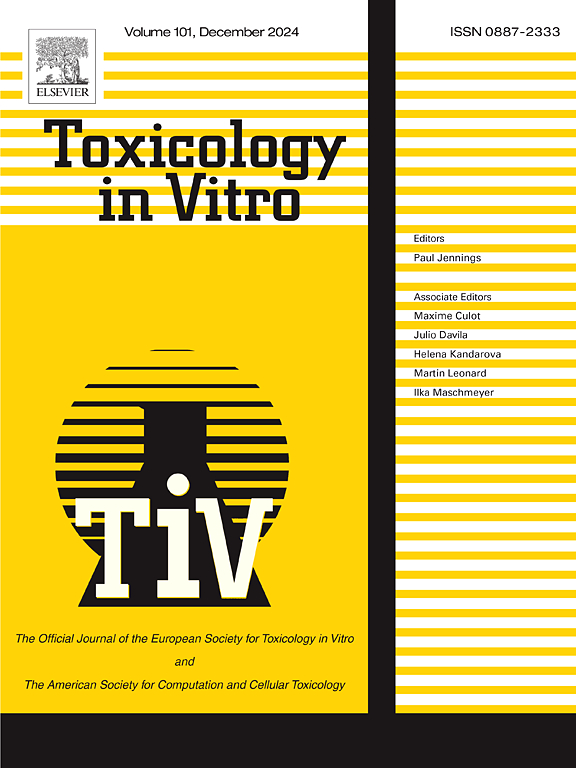在腐蚀性化学物质(次氯酸钠)暴露后,用缓冲的维生素C洗涤可减少眼部损伤深度。
IF 2.6
3区 医学
Q3 TOXICOLOGY
引用次数: 0
摘要
化学眼睛伤害发生在家庭、工业和军事环境中。眼睛接触化学毒素后的标准建议治疗方法是用自来水冲洗至少15 分钟。估计80% %的眼部毒素与活性氧和/或极端ph值有关。使用食物来源的眼睛和市售的损伤深度测试试剂盒(IVD EITTM),通过碎片化DNA染色测量死亡角膜角质细胞的深度,用缓冲的维生素C溶液冲洗眼睛,与对照组相比,明显减少了角膜角质细胞的死亡和损伤深度。眼睛洗时(使用一瓶500毫升的无稽之谈) 15分钟后与水接触32 %次氯酸钠(含氯漂白剂)损伤的深度是59.6 ±3.6 %,预计将造成一定程度的破坏极限/永久眼睛受伤甚至失明体内(极端或不可逆损伤,gh类别1),但洗后0.2 %缓冲维生素C漂白剂暴露减少损害to13.8 ±1.4 %,显著减少(P本文章由计算机程序翻译,如有差异,请以英文原文为准。

Washing with buffered vitamin C after corrosive chemical (sodium hypochlorite) exposure reduces ocular depth of injury
Chemical eye injuries occur in home, industrial, and military settings. The standard recommended treatment after exposure of the eyes to chemical toxins is washing with tap water for at least 15 min. An estimated 80 % of ocular toxins are associated with reactive oxygen species and/or extreme pH. Using food-source eyes and a commercially available test kit for depth of injury (IVD EITTM) that measures the depth of dead corneal keratocytes by fragmented DNA staining, washing the eye with a buffered vitamin C solution significantly reduced corneal keratocyte cell death and depth of injury compared to control. When eyes were washed (using a 500-mL eyewash bottle) for 15 min with water after exposure to 32 % sodium hypochlorite (chlorine bleach), the depth of injury was 59.6 ± 3.6 %, a level of damage predicted to cause extreme/permanent eye injury or even blindness in vivo (extreme or irreversible injury, GHS category 1), but washing with 0.2 % buffered vitamin C after bleach exposure reduced damage to13.8 ± 1.4 %, which is significantly less (P < 0.001) and predicted by the IVD EIT method to be reversible irritation (GHS category 2) that will heal within 21 days in vivo.
求助全文
通过发布文献求助,成功后即可免费获取论文全文。
去求助
来源期刊

Toxicology in Vitro
医学-毒理学
CiteScore
6.50
自引率
3.10%
发文量
181
审稿时长
65 days
期刊介绍:
Toxicology in Vitro publishes original research papers and reviews on the application and use of in vitro systems for assessing or predicting the toxic effects of chemicals and elucidating their mechanisms of action. These in vitro techniques include utilizing cell or tissue cultures, isolated cells, tissue slices, subcellular fractions, transgenic cell cultures, and cells from transgenic organisms, as well as in silico modelling. The Journal will focus on investigations that involve the development and validation of new in vitro methods, e.g. for prediction of toxic effects based on traditional and in silico modelling; on the use of methods in high-throughput toxicology and pharmacology; elucidation of mechanisms of toxic action; the application of genomics, transcriptomics and proteomics in toxicology, as well as on comparative studies that characterise the relationship between in vitro and in vivo findings. The Journal strongly encourages the submission of manuscripts that focus on the development of in vitro methods, their practical applications and regulatory use (e.g. in the areas of food components cosmetics, pharmaceuticals, pesticides, and industrial chemicals). Toxicology in Vitro discourages papers that record reporting on toxicological effects from materials, such as plant extracts or herbal medicines, that have not been chemically characterized.
 求助内容:
求助内容: 应助结果提醒方式:
应助结果提醒方式:


